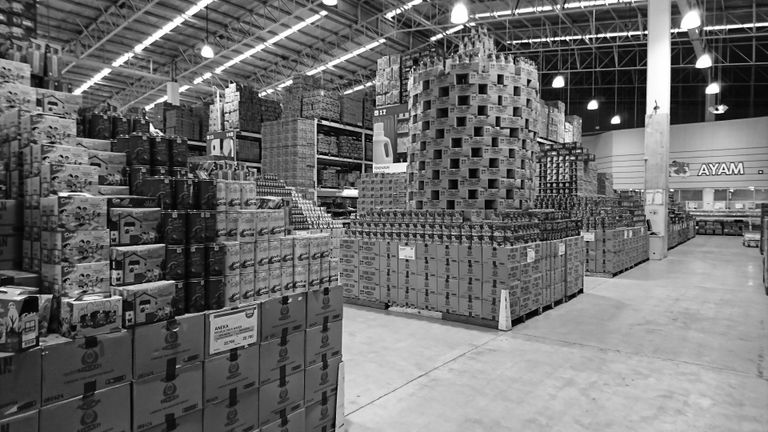Rules to follow in this Black & White photography challenge:
- Your own photo
- Black and white images that represent any positive meaning in life
- Present one or two image every day
- You may add people, if you want
- No explanation
- Use one of your tags #bnwphotography
Thanks For Stopping By
beben

Berikut di bawah ini adalah aturan yang harus diikuti dalam tantangan fotografi Hitam Putih:
- Harus foto milik anda sendiri (diambil oleh anda)
- Foto hitam putih yang mewakili setiap makna positif
- Posting satu atau dua foto setiap hari
- Anda diperbolehkan memposting orang, kalau memang anda inginkan
- Tidak perlu penjelasan tentang foto yang anda posting
- Gunakan tagar #hitamputih
Terima Kasih Atas Kunjungannya
beben

Black and White Photo Capture Techniques
You will be brought to the understanding that black and white photos are beautiful, beautiful, have strong artistic value, are dramatic, and have character. Ancient, old school, and old are actually not something that is unattractive, but just a phrase that some people who don't quite understand understand it only at a glance without considering the value aspect of the depth of the black and white photo. One more word that we may often hear to judge black and white photos, namely simple. It doesn't matter if in the end there are still simple words to understand black and white photos, but the simple phrases that are said will have something that actually cannot be expressed in words that will bring pleasure to looking at black and white photos compared to color photos.
Simple. But second to none. The message conveyed by the black and white photo is deeper and more dramatic. This can happen if the photo taking is done with sincerity and good inspiration and imagination. Because if this is not the case, the black and white photo will return to its original meaning, which is boring. There are several techniques or perhaps more precisely ways that can be done as preparation for taking black and white photos, namely:
1. Defining Object
In determining the object to be photographed, we must be able to select it first. The thing that must be considered in choosing an object to be photographed is to identify it. We need to know what objects will be beautiful when used as black and white photos, because not all objects will be good for black and white photos. For example, we chose a rainbow as an object for a black and white photo, of course it's not good because basically what's interesting about a rainbow is its various colors that form something beautiful to look at. Or a landscape of sunrise and sunset, of course it will be less attractive if it is used as a black and white photo because what makes it beautiful is because there are different colors of the sky which give it a distinctive feel. In addition, objects that want to emphasize the impression of color are also not suitable for black and white photos, such as colorful flowers and beautiful fashion elements when using color as an allure. Although it does not rule out the possibility that it can be used as a black and white photo with the consequence that a little value is lost if indeed the strength is in various colors. So what kind of object is good for black and white photos? Namely objects that have a historical impression, portraits that want to show a dramatic and detailed impression (for example objects of old people), or objects that want to show a strong impression of contrast. Apart from that, other objects can also be used as black and white photos depending on the imagination of the photo taker.
2. Direction of Light
The direction of light in photography is important, because knowing the direction of light and setting it to the object will greatly affect how the photo looks. The direction of light determines the character of the light itself as well as determines the impression and dimension you want to create on the object.
The direction of light, both natural i.e. sunlight and from artificial light sources can
divided into five, namely:
a) Front Light (Front Light)
Front light means that the light source is in front of the object in the photo, so usually the light source is behind our camera. Front light can come straight to the object, like when we face the sun at sunrise on the beach. The front light can also form an angle, like when we face the sun at 10 o'clock in the afternoon. With artificial light, we can make the front light right in front of the face or form an angle to the face. The majority of photos are produced with a light source that is in front of the object. An even front light makes a photo beautiful.
b) Side Light (Side Light)
Light hits the subject from the left or right side. This side light gives a strong dimensional impression that is why it is widely used in architectural photographs. Lighting from the side will also strengthen the texture of an object. Side light is light that makes changes to shadows. When taking pictures of the face, acne will be further strengthened if we use side light. Side light photos will usually be good when used to shoot black and white.
c) Top Light
By using top light in a portrait photo, the shadow of the nose will appear under the nose. This top-lit photo is great for cosmetic photos. This photo can be taken at 12 noon to get direct sunlight.
d) Down Light (Down Light)
Most scenes that use light from below are in a horror setting.
e) Back Light
Back light occurs when we photograph a subject with a light source coming from behind it, in other words the light source is in front of the camera but behind the object. When we photograph a subject with its back to the sun, for example photographing a friend facing east at 4 pm there will be back light. With our backs to the light source, we often produce silhouette photos. The majority of backlight photos will highlight the shape and profile of the object being photographed. Avoid lighting from behind if you don't want a silhouette photo.
After the three things above, the next thing to do is:
1. Use RAW Format
Not many people know about this RAW format, or maybe it's because their camera doesn't have this format, or maybe it's because they really don't like using this format. However, we need to know that the RAW format has several advantages, namely by using the RAW format, processing of photo files in the post-production phase will be easier, control when converting from color photos to black and white photos will be maximized, have higher flexibility and tolerance. better quality, more detailed photo quality, and keeping the original photo in color.
2. Take Color Photos
When our camera doesn't have RAW format, then take a color image and convert it to black and white on the computer. Even though the camera provides a black and white format, it would be better if we still use the RAW format or if you don't have one then use the color format.
3. Use Low ISO
This is done to reduce the effect of noise on photos when converted to black and white. Noise is the tiny white spots in a photo that appear more clearly on a black and white photo than on a color photo. By using a low ISO, this noise will be minimized so that the photo quality is maximized. Low ISO is also good to use when shooting in locations with sufficient light. Low ISO is able to capture the contrast well which will make the black and white effect more effective. But if you want noise, then keep using a low ISO and we can add noise in the post-production process. A high ISO can be used if you get a high shutter speed or a dramatic grain effect on purpose.
4. Shooting Time (Photo)
As explained earlier, that black and white photos can be made from photos taken from shooting techniques directly into the sun during the day to get a good silhouette element. However, even black and white photos are good if taken when the sun is low, namely in the morning or evening, so that they produce a strong dramatic element. However, if taking pictures in the evening is done on color photos, it will result in under-exposed photos.
b. Lighting Engineering
This technique is one of the vital things in photography, because no matter how good the camera and object are, when the lighting is not good, the results will not be optimal. Therefore, it can be said that light is the main requirement for producing good photographic images. The shutter speed, aperture and ISO that we set in such a way are our steps to get good lighting. Good ratings in photos are relative, but when photographers or non-photographers take pictures with all good planning and the message you want to convey can be realized in the photos, each will have added value. In addition, a good photo is a photo where the lighting matches the composition of the object being photographed.
Things to pay attention to from lighting are:
- Light Intensity
The photo is taken with a balanced light size so that the photo looks more natural. However, if we want to take photos under or over then set the exposure in such a way that our photos will look pleasing to the eye and have artistic value. Setting the light intensity is done because this is the strength of the light.
2. Direction of Light
The direction of light in photography is an important thing, because knowing the direction of light and setting it to the object will greatly affect how the photo looks. The direction of light determines the character of the light itself as well as determines the impression and dimension you want to create on the object.
The direction of light, both natural i.e. sunlight and from artificial light sources can
divided into five, namely:
a) Front Light (Front Light)
Front light means that the light source is in front of the object in the photo, so usually the light source is behind our camera. Front light can come straight to the object, like when we face the sun at sunrise on the beach. The front light can also form an angle, like when we face the sun at 10 o'clock in the afternoon. With artificial light, we can make the front light right in front of the face or form an angle to the face. The majority of photos are produced with a light source that is in front of the object. An even front light makes a photo beautiful.
b) Side Light (Side Light)
Light hits the subject from the left or right side. This side light gives a strong dimensional impression that is why it is widely used in architectural photographs. Lighting from the side will also strengthen the texture of an object. Side light is light that makes changes to shadows. When taking pictures of the face, acne will be further strengthened if we use side light. Side light photos will usually be good when used to shoot black and white.
c) Top Light
By using top light in a portrait photo, the shadow of the nose will appear under the nose. This top-lit photo is great for cosmetic photos. This photo can be taken at 12 noon to get direct sunlight.
d) Down Light (Down Light)
Most scenes that use light from below are in a horror setting.
e) Back Light
Back light occurs when we photograph a subject with a light source coming from behind it, in other words the light source is in front of the camera but behind the object. When we photograph a subject with its back to the sun, for example photographing a friend facing east at 4 pm there will be back light. With our backs to the light source, we often produce silhouette photos. The majority of backlight photos will highlight the shape and profile of the object being photographed. Avoid lighting from behind if you don't want a silhouette photo.
- Zone System
History and Understanding of the Zone System
The zone system is a theory developed by Ansel Adams and Fred Archer as a teaching aid while they were teaching at the Art Center School in Los Angeles in the 1940s. It became clear to Adams and Archer that the way to unleash student creativity was to provide a practical system that will guarantee the 'correct' result and allow visualization (knowing how the final image will look at exposure). Quoting Ansel Adams from his autobiography. "Craft facilities liberate expression, and I'm always amazed how many artists think the opposite to be true." The zone system is mistaken by many for photographers using large format cameras and working only in monochrome. This is absolute trash. The zone system is a method of controlling subject exposure (using a light meter) and when using film, negative contrast (using expansion). With a digital camera the exposure procedure is identical to that of a film camera! 'Contrast control' aspects of film development can be tweaked and incorporated into the digital photographer's mind by linking film development to digital 'Curves' to allow the digital photographer to create different, but carefully controlled, subject exposures to capture the full range of contrast. The images can then be combined in software to create either an HDR image or a layered contrast controlled composited image. The two controls, exposure and development, work regardless of which film is used, does not determine what film will be used. Every time you press the shutter release you are making an exposure and once the film is exposed it needs developing to produce the image (assuming a silver based method, not digital). This procedure applies to mono negatives, Color negatives and trans colors in whatever format you choose (110 and above). The only difference is in the way the system applies depending on the format used. Obviously, with sheet film you can develop each negative separately (ideal) but with roll film (35mm and 120) the entire roll tends to be developed at the same time. This can allow in your working method! Ansel Adams used all formats, including Polaroid (he is a consultant for Polaroid), for his images made in both color and mono using the Zone system. Many 'experts' in photography have made a reputation for trying to reinvent the wheel and come up with their own systems. They then claim their system is in some way superior to that market, usually including trying to undermine the Zone system for doing so. As soon as you see these 'systems', you realize that they are just a Zone system with another name. The Zone system is a practical application of photographic sensitometry, and the principles of sensitometry have not changed dramatically since their inception. Any exposure/development control system must be based on sensitometry, it must be based on the original Zone system.




** Your post has been upvoted (3.34 %) **
Curation Trail is Open!
Join Trail Here
Delegate more BP for bigger Upvote + Daily BLURT 😉
Delegate BP Here
Upvote
https://blurtblock.herokuapp.com/blurt/upvote
Thank you 🙂 @tomoyan